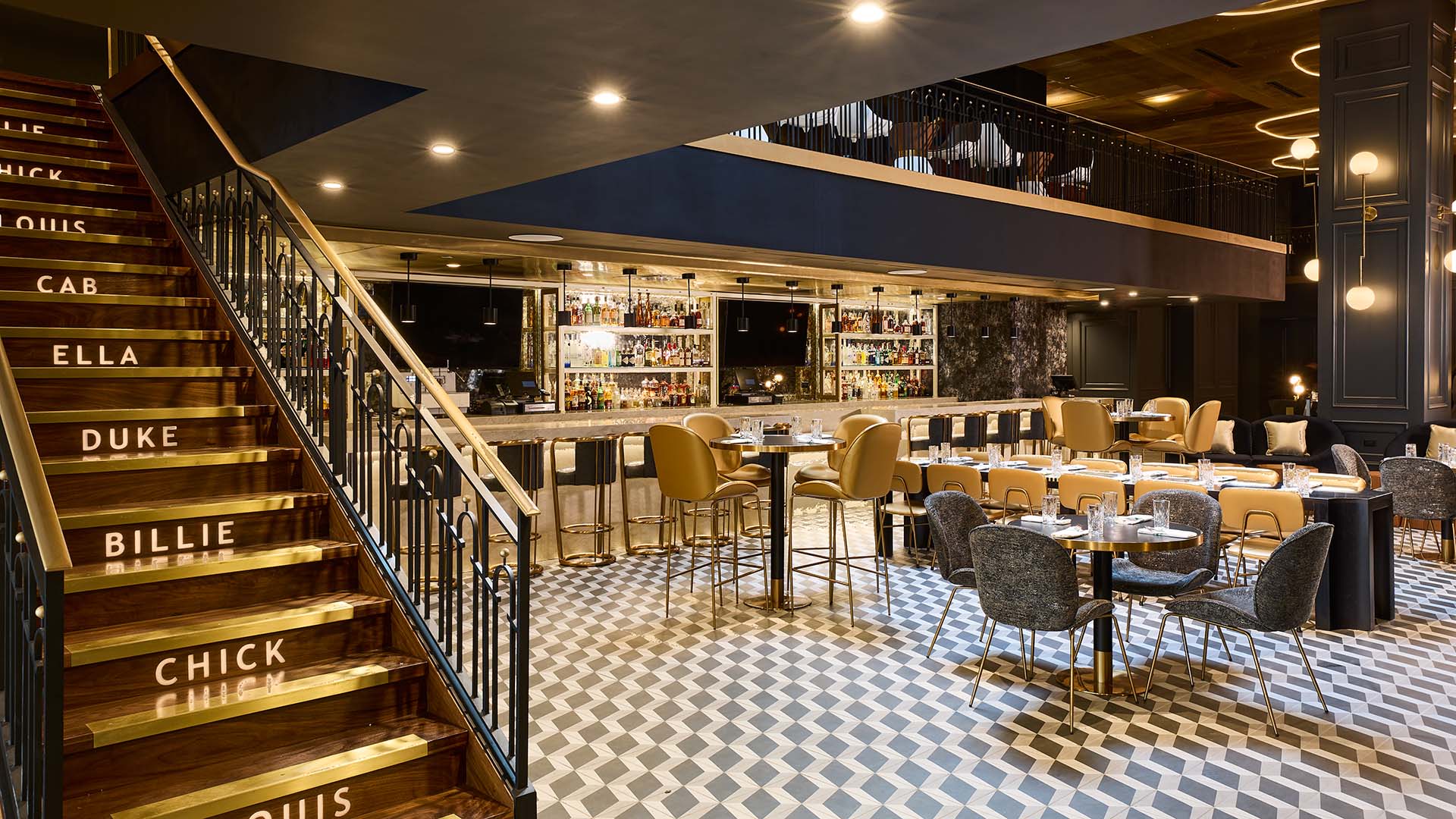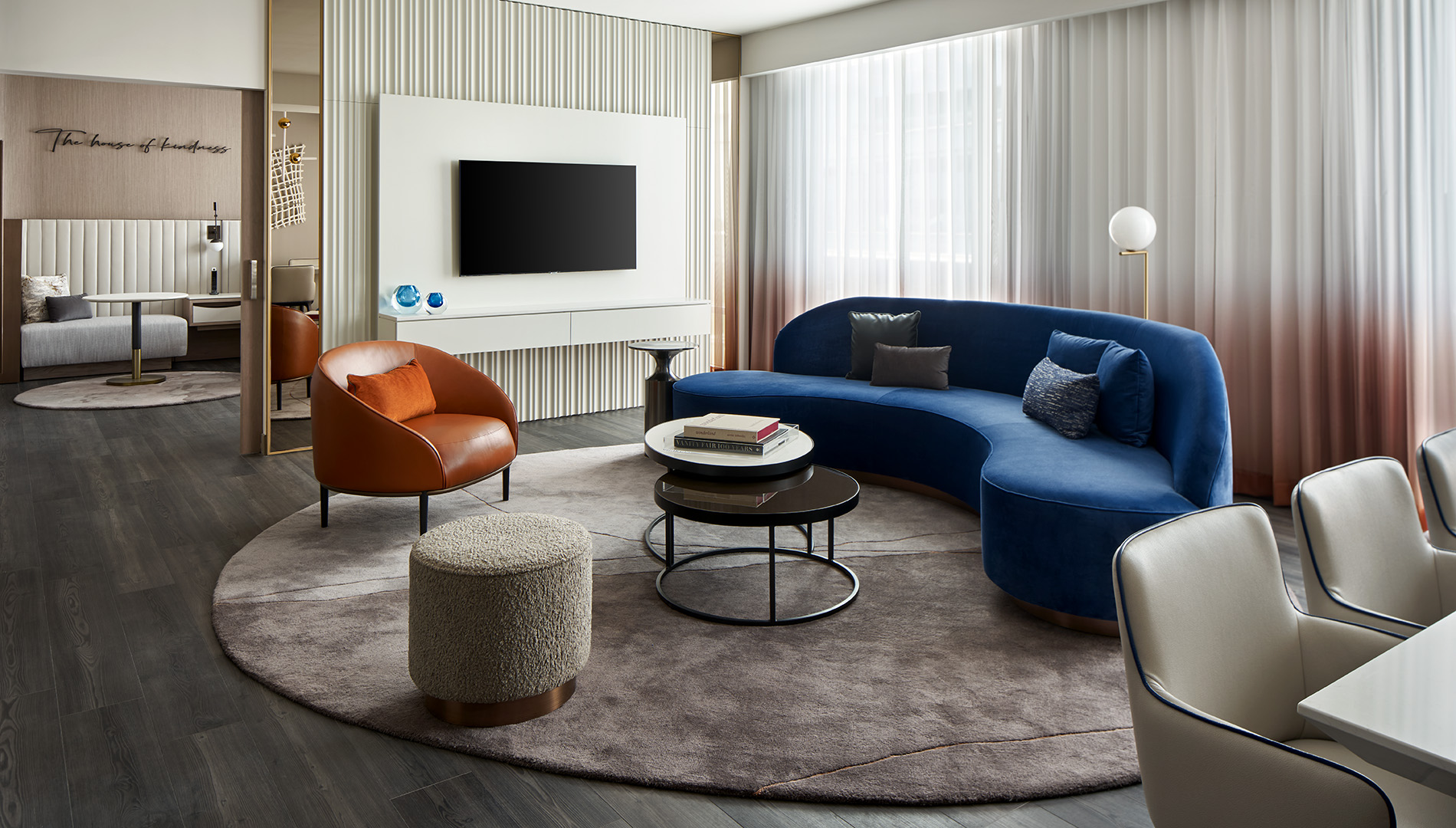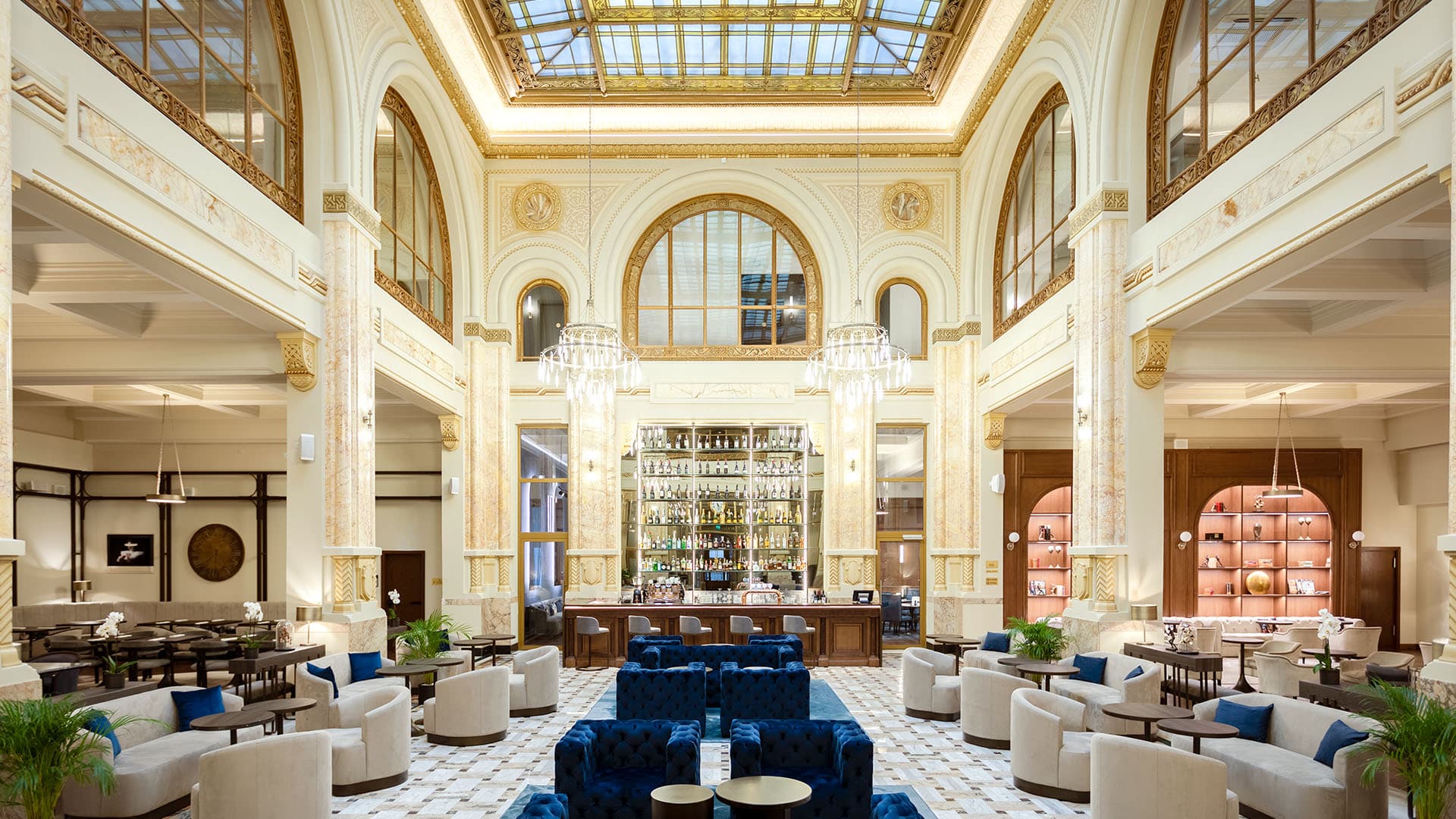
(Photo: Marriott International)
Travel by DesignMeet for Drinks in a 100-Year-Old Bank Vault at The Marmorosch Bucharest, Autograph Collection
By Hamish KilburnBucharest, the capital city of Romania, is a rising destination for travelers who want to visit a vibrant European city with a fantastic local food scene, access to breathtaking countryside excursions, and centuries of historic architecture.
Tapping into that history is The Marmorosch Bucharest, an Autograph Collection Hotel. This hotel was crafted inside the Marmorosch-Blank Bank Palace, a stately building in the heart of old town Bucharest that was originally constructed in 1912. Previously critical to the modernization of the Romanian economy, the bank building is now a protected national monument — with intricate woodwork, stained glass, and marble tiling throughout.
To keep the heritage of the Marmorosch intact, architect Indre Sangus had to untangle a labyrinth of design challenges. From encasing carved wood panels in glass so they could function as shower walls, to preserving marble by hiding above-ground plumbing inside furniture, she came up with solution after solution to preserve over a century of history at the heart of Bucharest.
In this conversation, Hamish and Indre clarify why it’s important to protect and restore this kind of heritage architecture and design, what it takes to restore over a century of craft for the public to see and touch once again… and what it was like to repurpose a two-story bank vault, deposit boxes and all, into an otherworldly speakeasy bar.
- 02:18 — Why do old banks make for wonderful hotels?
- 05:17 — Why is it so important to preserve the heritage features of this building?
- 06:50 — How did Indre solve problems like turning hundred-year-old, wood-paneled rooms into fully functional hotel bathrooms?
- 12:25 — What was it like to turn a bank vault into a speakeasy bar?
Featured Hotel: The Marmorosch Bucharest, Autograph Collection
Featured Designer: Indre Sangus, YES.design.architecture
Explore more stories about hotel design at Travel by Design
Follow host Hamish Kilburn’s hotel design reviews @HotelDesigns and global travels @hotel_travel_editor
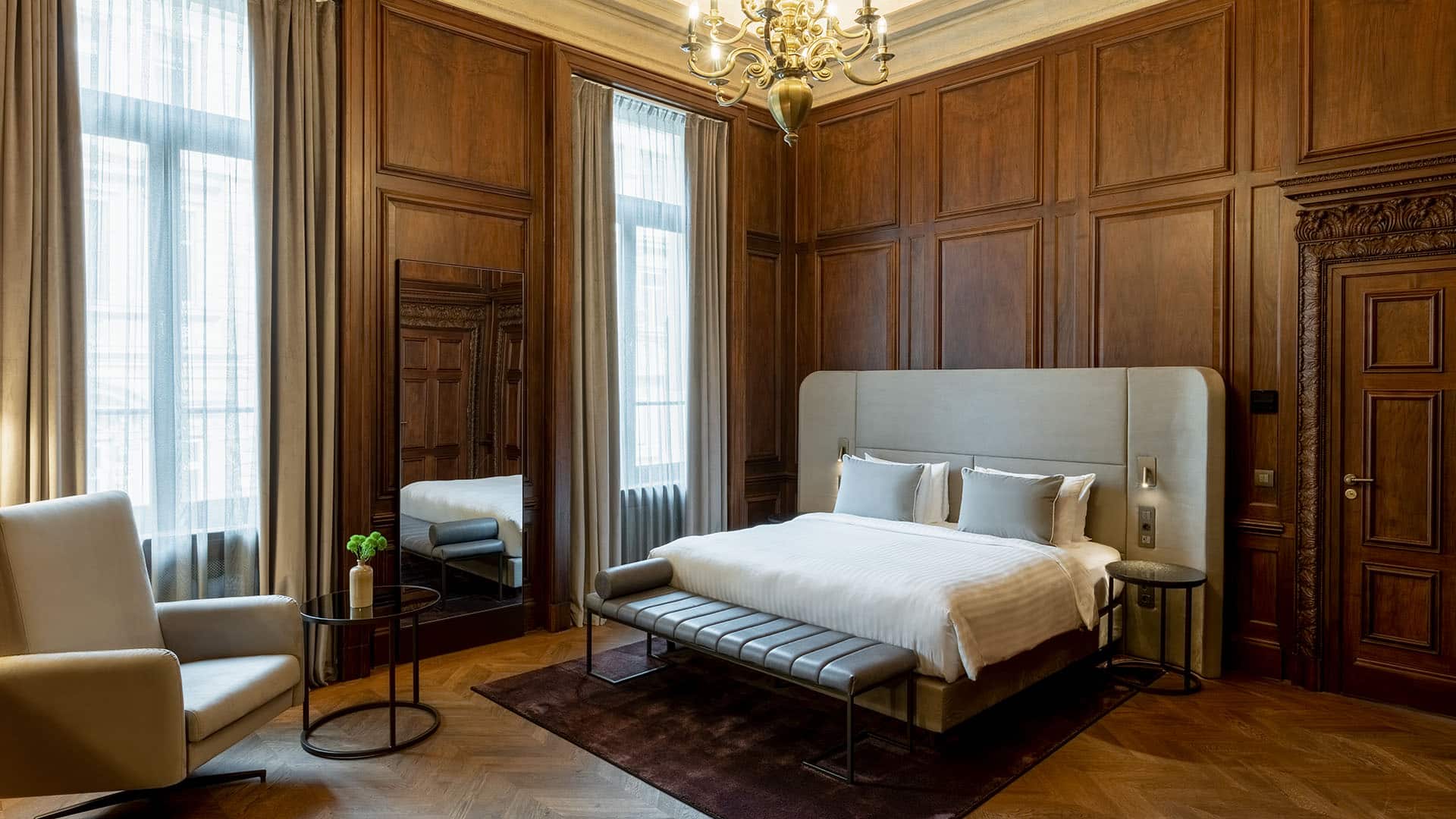
TRANSCRIPT
Indre Sangus: We’re using modern elements, but we are trying to design so that it does not overwhelm heritage.
MUX Begins — “B2B” by Rocket Jr, mixed with “Aeronautics” by _91nova
So when we had to get water or ventilation pipes into some areas, we had to go around the areas that we couldn’t touch.
So that meant we were not only designing furniture and, you know, deciding on colors and textures, we were also drawing the geometry and the path of those wires and of those, you know, pipes, so that they do not ruin the design.
Show Open
HAMISH VO: This is Travel by Design — where we chat with the visionaries behind the world’s most extraordinary hotels.
I’m your host, Hamish Kilburn, professional hotel reviewer and the editor of Hotel Designs.
Today, our destination is Bucharest, the capital of Romania.
It’s a colorful, vibrant city. With an annual flower festival, excursions to the breathtaking countryside, and a kaleidoscopic diversity of architecture.
The buildings here tell the stories of generations. And my guest for today is Indre Sangus, who helped turn one of the most historic buildings in the city into The Marmorosch Bucharest, an Autograph Collection Hotel.
Indre Sangus: I am representing Yes.Design. And I am leading architect.
We keep growing and growing, and as we see now, we are already going international. So that’s very good… (laughs lightly)
Hamish VO: Indre’s team restored the Marmorosch-Blank Bank Palace, a heritage building originally constructed in 1912.
The bank sits at the heart of old town Bucharest, and it looks very much like a palace. Towering corners and elegant arches frame the facade, and there’s a glowing gold trim around the front entrance.
Because this building was a protected national monument — with intricate woodwork, stained glass, and marble tiling, which couldn’t be disturbed — Indre took on challenge after challenge to build a fully functioning hotel inside.
But before we talked about how she overcame those challenges, I asked her a question regarding bank buildings that I’d always wondered about.
MUX Ends
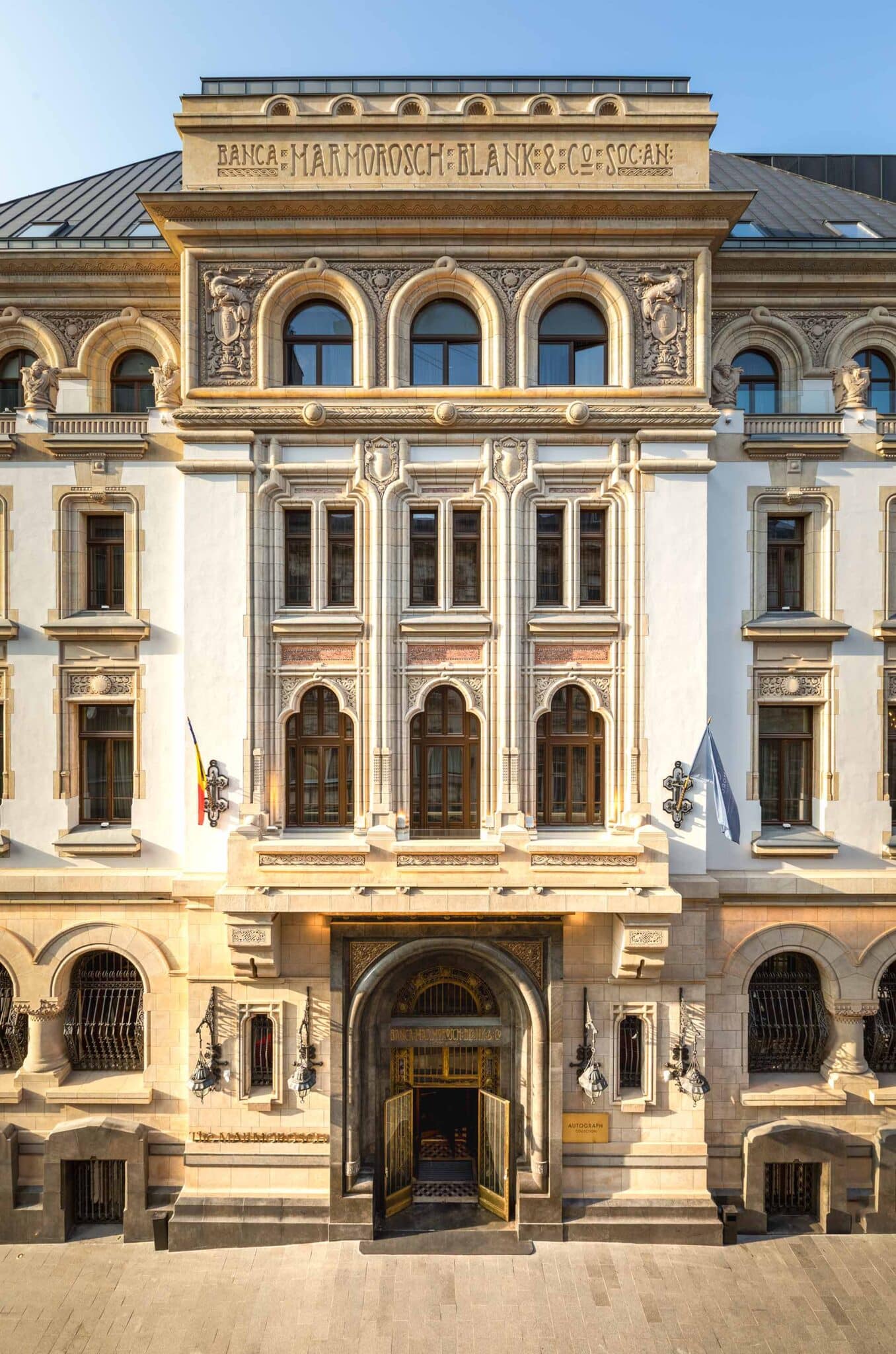
Act 1: Why preserve the Marmorosch Bank Building as a hotel?
Hamish Kilburn: Old banks… they make for wonderful hotels. Have you noticed this before?
Indre Sangus: Definitely, definitely. Most of the spaces that were in the bank, they still serve almost the same function.
Okay. It’s not about the going to the bank and taking out or putting in your money, but still, it’s public space. It still has lobby. It still has meeting rooms. It still has small offices.
In terms of layout, yes, uh, we added more rooms, but the public spaces that were the main areas in the bank as well, still remained.
Hamish Kilburn: Indre, I’m really struck by how your process is about revitalizing the historic Marmorosch bank building itself. You know, it’s not replacing it.
Indre Sangus: Mmhm.
Hamish Kilburn: We’re talking here about a building that played a vital role in modernizing the Romanian economy, and it was constructed after the First World War…
Indre Sangus: Mmhmmm.
Hamish Kilburn: But I’d love to know, what was the building like when you first walked into it?
Indre Sangus: So I can tell you even one step before, I remember very well when the, this future client called us and told about this site, that it’s bank and is going to be transformed into hotel.
It already sounded amazing. But when we went to the site, it was even more impressive because the building itself is very, uh, big and, uh, almost, uh, one of the most impressive building in Bucharest.
You see this beautiful facade, which is covered in natural stone and lots of ornaments.
At the same time, the stones of the facade is almost falling apart…
Hamish Kilburn: Mm.
Indre Sangus: Yeah, and it was not that abandoned, but for some of I guess a decade, it was just not functioning anymore, so it feels like only the ghost lived there.
We immediately understood that all this, that we see now, has to be brought to second life, and this, we understood from the very first, uh, visit, because you can literally feel, smell, touch items that were built so long time ago, and it’s still there.
I think that makes the experience for each guest even more stronger.
Hamish Kilburn: There’s so many layers. There’s many original layers. I can just imagine, as a designer, it must have just been like every designer’s dream to win a project like this, that has so much texture.
Indre Sangus: Yes! It’s a dream, but it’s also big responsibility, you know, because, uh, you have know how not to ruin it, and, uh, what to emphasize on, because there are so many important things.
Hamish Kilburn: So this building is classified as a class A historic monument by the Romanian government, so that basically means that it’s a national treasure.
I just want to really understand, why were they so important to keep intact?
Indre Sangus: So when you go to these rooms, you immediately see the most preserved thing, uh, in almost all the building, it’s wooden panels.
Hamish Kilburn: Mm.
Indre Sangus: Which is, uh, very surprising that they are still there, because you know, wood is quite, uh, sensitive, and imagine that all walls are covered in wooden panels, and it gives you immediately the sense of something royal and very grand.
Imagine that each wooden panel is done, um, is handcrafted. Maybe it was started by one person, and somebody else finished it because it takes so long to make it…
So it’s valuable feature to keep these elements and appreciate that somebody put so much work into that.
Hamish Kilburn: Preserving craft, isn’t it?
Indre Sangus: Exactly.
You know, now we’re living in, uh times when we are used to a very fast lifestyle and, uh, we are not working so hard on features like that, like wooden panels or moldings — not because they are not nice or they’re not attractive anymore. It’s because it doesn’t just fit our lifestyle anymore, because we want everything fast and right away, and these elements, they just take ages.
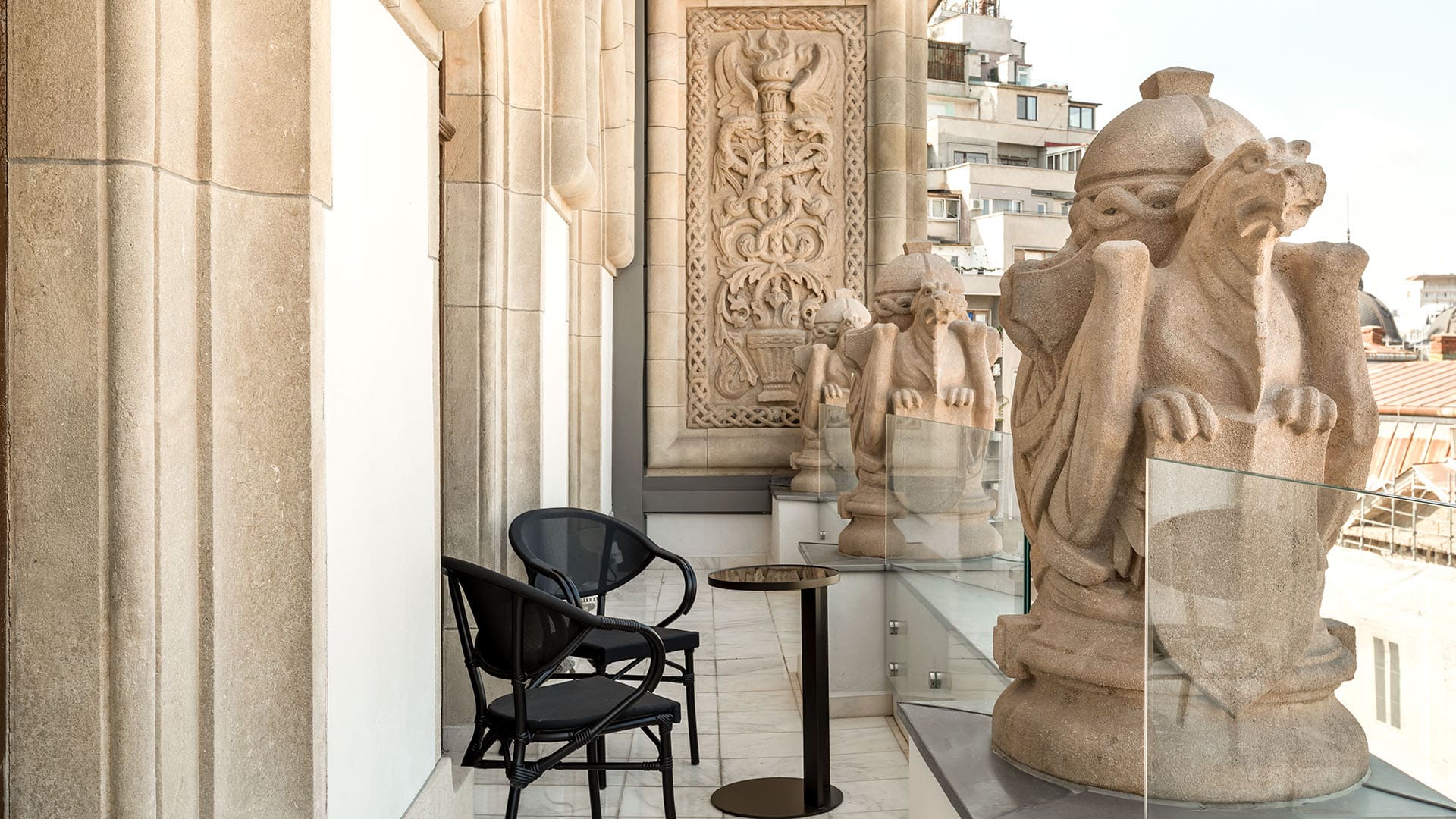
Act 2: How Indre preserved over a hundred years of heritage in a modern hotel
Hamish Kilburn: The more you talk, and the more I get understanding of this project, I just can’t help thinking how much of a huge architectural challenge it was.
If you’re trying to keep so much of the original flooring and the original walls, for example, if preservation in this case means the look and feel of the whole interior has to stay the way it was a hundred years ago, then…
I don’t really have any idea how, how you would then go about installing things like new wiring into the walls, and putting new plumbing in, and getting air conditioning in, so that it is suitable for customer experience and not just look and feel, as you’ve mentioned, with the old and the new and the contemporary elements that are so sort of sensitively blended in.
Indre Sangus: Yes, it’s, it’s almost like a separate project!
A separate project, because, because I remember when we had to get, uh, for example, water into certain areas or ventilation pipes into some areas, we had to go around the areas that we couldn’t touch…
So that meant we were not only designing the, um, furniture and, you know, deciding on colors and textures, we were also drawing the geometry and the path of those wires and of those, you know, pipes, but it was labyrinth, I could say. It was literally a labyrinth, so that they do not ruin the design.
Hamish Kilburn: Yeah.
Indre Sangus: We had, uh, this lobby bar and we had this authentic marble flooring…
Which, we couldn’t even touch it, because it was just too difficult to reassemble.
So, to get water into lobby bar, we had to build the form and the shape of the bar, not based on how we wanted it to be or how it was fitting best in the space, but based on the geometry of this water pipe.
So the solution was to use the furniture as a path for these pipes.
Although nobody can see it now. (Giggles slightly)
Hamish Kilburn: Wait a minute, so I’m looking at a photo of the lobby bar… so you’re telling me that the pipework is inside the furniture, and inside the bar itself?
Indre Sangus: Yes, yes, now, when you see the final, uh, you know, result, you will not even identify things like that, but at that time it was really a big challenge.
Hamish Kilburn: Mm. And when you, when you mention challenges with, with pipes for, for water…
I mean. I have spoken to hundreds of architects and designers who have worked on heritage buildings and they all have the same problems.
Indre Sangus: Definitely, it’s not different story here. (Laughs)
We also had challenges with bathrooms…
Hamish Kilburn: (Giggles)
Indre Sangus: They were all covered in wood.
And this means that we have to have, for example, new shower in our guest bathroom, but we have wooden panels, so what should we do?
So, for example, in one room, the wall is covered in glass, and the wooden panel is behind, with a, with a light. It even looks better. But of course it’s protected from humidity, and you can freely have a shower and not damaging the wooden panel, but you can still feel the wood around you, which is quite exclusive, I would say.
Hamish Kilburn: Yeah.
Indre Sangus: Mmhmm.
Hamish Kilburn: Yeah, and as the traveler, you’ll really feel like you’re part of a historic building, even in that moment of, of being in the bathroom, and showering.
Indre Sangus: Yes. And one of the bathroom we just decided to replace the existing wooden panels, uh, into a marble panels…
But Historical Preservation asked us to keep the pattern of the previous wooden panels.
Hamish Kilburn: In the marble?
Indre Sangus: Yes.
Hamish Kilburn: Whoaaaa.
Indre Sangus: For example, the panel was a one meter width and, uh, three meters height. So we had to cut the stone into the same pieces and also add engraving.
Because the, these wooden panels, they had those moldings and engravements.
And at the end of the day, you get a very interesting result.
Hamish Kilburn: There’s a problem and there’s a solution, but it’s got character, it’s got style, that’s kind of what it’s feeding the, the traveler, I guess.
Indre Sangus: Mmhmm. But the process of this, of this small, small thing was almost two months.
We ask the heritage department, if we’re allowed, then they give us response, then we ask the engineers, then they give us response, then we build the new solutions…
Hamish Kilburn: Mmhm.
Indre Sangus: …and it has to be a teamwork, I would say, and in this case, everybody were taking care of this building as if it’s their home, you know.
Hamish Kilburn: I guess you have to, though.
Indre Sangus: Yes, yes!
We did something that we had to do because now everybody can experience this amazing architecture, this amazing building, amazing interiors… it’s open for everybody, you just have to go and experience, so…
It’s not for us, you know, we did not do it for our portfolio or just because we like beautiful buildings. We wanted it really to be for public, and the hotel gives this opportunity for everybody to experience it.
Because you just have to book a room and go.
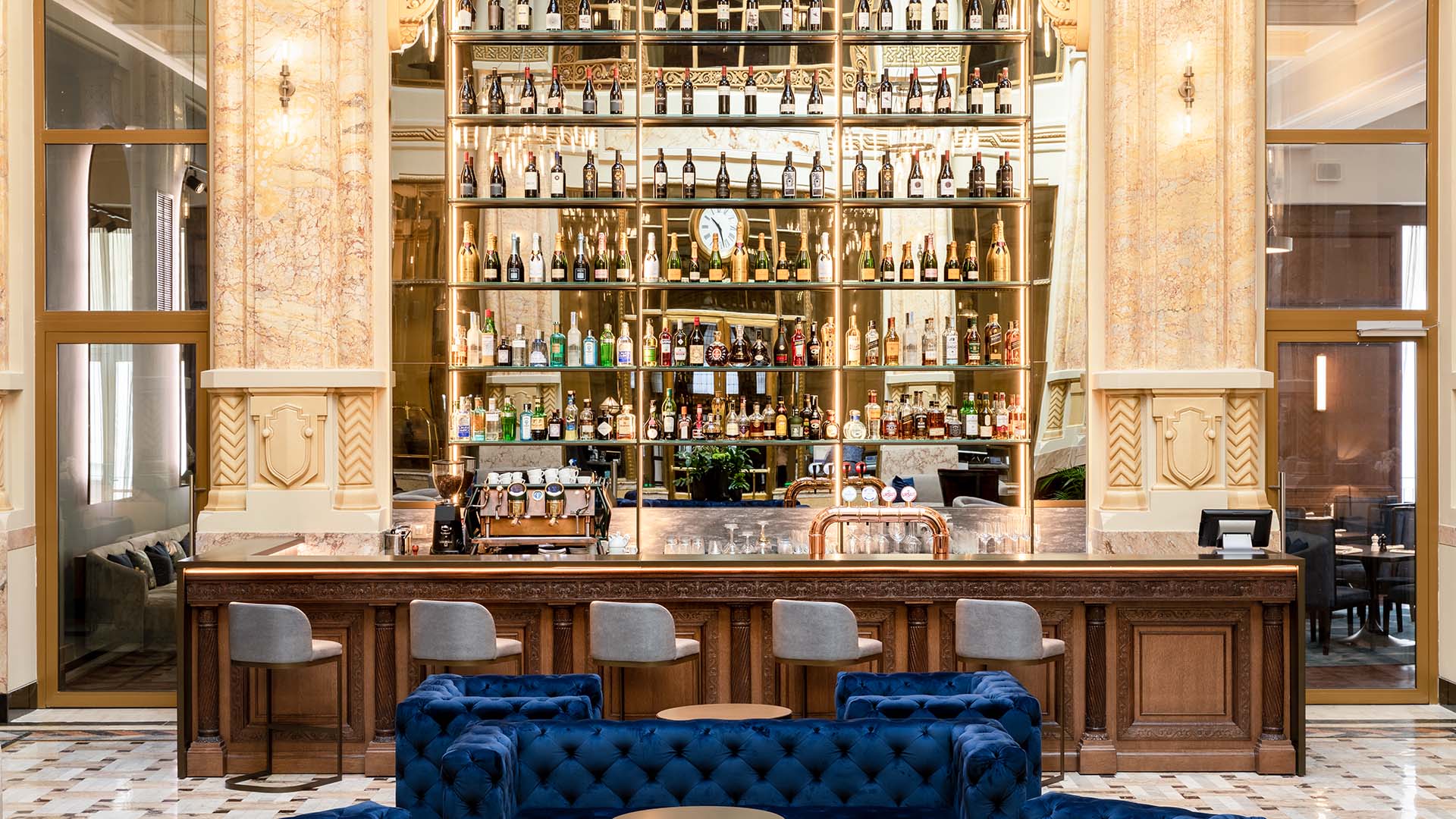
Act 3: Having a cocktail and opening your own lockbox in the bank vault
Hamish Kilburn: I’ve been saving, um, this last space of the hotel for now, because I think it really deserves its own moment, and that’s the bank vault, the speakeasy bar.
And obviously it’s built into the original bank vault itself.
Indre Sangus: Yeah, it’s a story behind…
The vault is, of course, in the basement of the old building. And when you go there, you already feel like you’re going to some secret place, you go downstairs. It’s a —
Hamish Kilburn: I love that.
Indre Sangus: — yes, it’s a little bit, you know, intimate atmosphere, no windows, and then you just see that round vault door, super heavy, super thick, and you still have that, uh, handle that you have to push in order to open these doors.
Hamish Kilburn: Yeah. Anyone who’s visiting Bucharest needs to experience descending into literal two story bank vault.
The walls are completely covered with deposit boxes.
But what I love about it is that you’ve also kind of added a faded gold matte finish that really catches the light with a little glow.
I’ve been to speakeasies before, but this is something else.
Indre Sangus: This is something else and it’s very rare. Quite a tiny space, I would say, uh, but what makes it uh, infinite is these deposit boxes that you mentioned.
Everywhere you can see the deposit boxes. So it makes you feel a little bit, you know, visually, like lost, or —
Hamish Kilburn: But you know, I, I think there’s something really poetic about this space, because it’s a space that would be completely private and obviously hidden from view in its former life.
And yet it’s a destination bar in itself, isn’t it? And those deposit boxes, I guess, make the guests kind of feel like they’re… (struggles to find the right word)
Indre Sangus: It makes you feel exceptional, I would say.
We even found the old keys of these deposit boxes, so in some deposit boxes, we decided just to keep these keys, so the guests can unlock the deposit box.
Hamish Kilburn: Oh wow.
Indre Sangus: Yes, the same box functioned long, long time ago, and now you can open this box, you can leave even a note for your friend in this box, lock it, and take this key to the receptionist and tell that, “Please give this key,” to the room number, this and that. And he will find my letter there. And it’s like finding a treasure.
Hamish Kilburn: Oh, I love that.
Indre Sangus: Mmhmm. It’s exceptional.
Hamish Kilburn: Indre, thanks so much for joining me today.
I, I really appreciate how diving into this restoration process of a heritage building, it really reveals so much history, but also so much new life for a building as well, and the potential to create new experiences.
And it being, at the heart of Bucharest, I know many memories will be made by the people visiting the hotel.
MUX Begins — “Overlander” by Steven Gutheinz
Thank you so, so much for exploring this building with us, and I can’t wait to experience it myself; I’m definitely going to leave a note in the deposit box for you.
Indre Sangus: Thank you so much. Thank you.
Credits
HAMISH VO: Travel by Design is a podcast by Marriott Bonvoy Traveler, the online travel magazine where you’ll find more inspiring hotel design stories.
If you’re curious about the craft of hotel design, then check out marriott bonvoy dot com slash travel by design.
And if you want to go behind the scenes of my travel experiences across the world, follow me on Instagram — @hotel_travel_editor.
This episode was produced by Narratively Creative. Our Senior Producer is James Boo. Our Associate Producers are Nidhi Shastri and Greta Stromquist.
Story edits by Priscilla Alabi, sound design by James Boo — and audio engineering by Dorian Love.
Our Marriott Bonvoy Traveler producers are Valerie Conners and Robin Bennefield.
Special thanks to Indre Sangus, for speaking with me about her work.
I’m your host, Hamish Kilburn. Don’t forget to subscribe to Travel by Design in your podcast app. And tune in next time to hear more design stories behind the world’s most extraordinary hotels.







